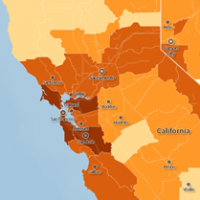Census Explorer Maps a Street View of Your Neighborhood’s Demographics

Big data, data collection, and data mining were undoubtedly some of the top tech trends and stories for 2013.
And while the data the National Security Agency has been amassing is regarded by many as THE top story overall, the government has been collecting information about us since Thomas Jefferson directed the first census in 1790. This current census data—a treasure trove of social, economic, and housing demographics—is now easier to use, with the government providing API access to some of the data sets.
The US Census Bureau released Census Explorer, a new interactive tool that lets you extrapolate data and create a street view map of demographics for your neighborhood, city, and state, comparing it against other areas of the country. This mapping tool is powered by American Community Survey (ACS) statistics from the Census Bureau's API, an application programming interface that allows developers to take data sets and reuse them to create online and mobile apps.
Not only is data from the 1990 and 2000 censuses included but also the latest ACS five-year statistics from the period 2008 to 2012. The United States housing bubble, economic crisis, recession, and aftermath are all within this critical time frame.
What can you find out? Go to Census Explorer to zoom in or enter an address for the data you’d like to map, including:
- Total population
- Percent 65 and older
- Foreign-born population percentage
- Percent of the population with a high school degree or higher
- Percent with a bachelor’s degree or higher
- Labor force participation rate
- Home ownership rate
- Median household income
According to the government, this is a pilot program and additional topics may be included in Census Explorer in the future.
However, there is additional information available at the neighborhood level through the American Community Survey statistics that includes more than forty social, economic, and housing topics, including health insurance coverage statistics. Approximately one in thirty-eight US households receives an invitation to participate in the American Community Survey each year.
So, what do you think? Did you learn anything new about your neighborhood?

